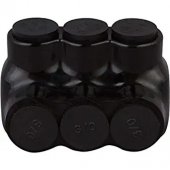I'm upgrading our off-grid household power system, and I have a choice to make.
Currently, the PV-only input is 8 x 375W panels. Each panel has a max amp rating of 9.43A and a max voltage just a hair under 40V. There are 4 serial strings (of 2 panels each) wired in parallel. The array feeds into a Renogy Rover 60A charge controller, which in turn feeds a 48V battery bank.
We are adding 4 more 375W panels (total of 12) and replacing the 60A charge controller with a Midnite Solar Classic 150 SL. The Classic doesn't have a fixed max output amp rating like the Renogy, because (according to the manual) it varies based on the PV input voltage. Here's the table showing the respective power curves for the Classic:

If I kept and expanded the current 80V configuration - 6 serial strings (of 2 panels each) wired in parallel - the max output amp rating for the Classic would be approximately 85A. Since 85A x 58.4V = 4964W, it could easily handle a maximum of 12 x 375 = 4500W from the panels. However, the max input amps would be 9.43 x 6 = 56.58A. This barely exceeds the NEC max current for 8 AWG wire (55A), which is the largest size MC4 connectors will fit.
On the other hand, if I rewired the panels for 120V - 4 serial strings (of 3 panels each) wired in parallel - the max input amps would go down to 9.43 x 4 = 37.72A, which 8 or 10 AWG wire (with MC4 connectors) could accommodate. However, the max output amp rating of the Classic at that input voltage drops to 76A. This would yield an output wattage of 4438W, which would lose 4500W - 4438W = 62W at the high end. It's not a lot, but I'd rather keep it, if possible.
So, is the 1.58A in excess of the NEC rating enough of a concern to avoid using 8 AWG wire, and rewire the panels for 120V and take the small power loss? Or is 1.58A close enough that I could keep the 80V wiring without worrying about it?
Of course, I realize there might be a third option: most of the length cabling from the panels to the charge controller will be two parallel lines of 10 AWG, for two reasons: 1) I can bring two separate 3 x 2 series-parallel arrays together with a 2:1 branch connector a few feet before the charge controller, and 2) the current pre-upgrade array already uses a 10 AWG cable, so I can just repurpose it and buy one more. If there's some easy off-the-shelf solution for connecting a 6 AWG length to an MC4 branch connector, I'm open to it. Even if it required a little crimping, it would still be preferable to the alternatives.
Any advice would be much appreciated.
Currently, the PV-only input is 8 x 375W panels. Each panel has a max amp rating of 9.43A and a max voltage just a hair under 40V. There are 4 serial strings (of 2 panels each) wired in parallel. The array feeds into a Renogy Rover 60A charge controller, which in turn feeds a 48V battery bank.
We are adding 4 more 375W panels (total of 12) and replacing the 60A charge controller with a Midnite Solar Classic 150 SL. The Classic doesn't have a fixed max output amp rating like the Renogy, because (according to the manual) it varies based on the PV input voltage. Here's the table showing the respective power curves for the Classic:

If I kept and expanded the current 80V configuration - 6 serial strings (of 2 panels each) wired in parallel - the max output amp rating for the Classic would be approximately 85A. Since 85A x 58.4V = 4964W, it could easily handle a maximum of 12 x 375 = 4500W from the panels. However, the max input amps would be 9.43 x 6 = 56.58A. This barely exceeds the NEC max current for 8 AWG wire (55A), which is the largest size MC4 connectors will fit.
On the other hand, if I rewired the panels for 120V - 4 serial strings (of 3 panels each) wired in parallel - the max input amps would go down to 9.43 x 4 = 37.72A, which 8 or 10 AWG wire (with MC4 connectors) could accommodate. However, the max output amp rating of the Classic at that input voltage drops to 76A. This would yield an output wattage of 4438W, which would lose 4500W - 4438W = 62W at the high end. It's not a lot, but I'd rather keep it, if possible.
So, is the 1.58A in excess of the NEC rating enough of a concern to avoid using 8 AWG wire, and rewire the panels for 120V and take the small power loss? Or is 1.58A close enough that I could keep the 80V wiring without worrying about it?
Of course, I realize there might be a third option: most of the length cabling from the panels to the charge controller will be two parallel lines of 10 AWG, for two reasons: 1) I can bring two separate 3 x 2 series-parallel arrays together with a 2:1 branch connector a few feet before the charge controller, and 2) the current pre-upgrade array already uses a 10 AWG cable, so I can just repurpose it and buy one more. If there's some easy off-the-shelf solution for connecting a 6 AWG length to an MC4 branch connector, I'm open to it. Even if it required a little crimping, it would still be preferable to the alternatives.
Any advice would be much appreciated.



